Carriage & Wagon Dept -
Stock Lists: Carriages, Vans, Wagons & Multiple Units -
C&W News
SR Coach Group - Goods Division -
Operation Undercover -
Technical -
Join us

London Brighton & South Coast Railway
Craven-era luggage/brake 2nd/3rd No. 221
recovered from Battle 26 August 2009
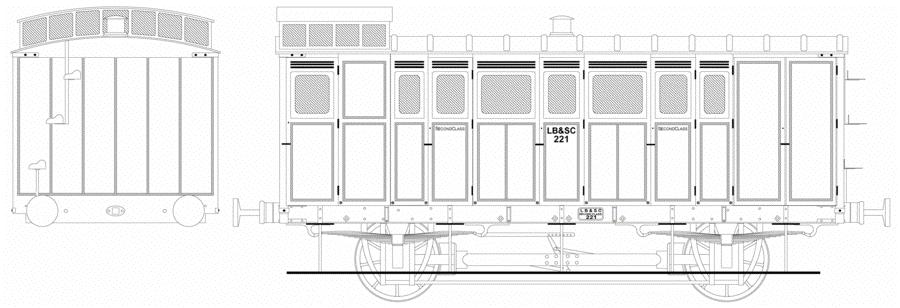
Above: Ian White's drawing showing what we believe the carriage would have looked like.
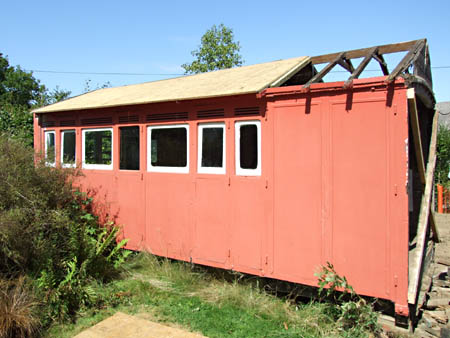
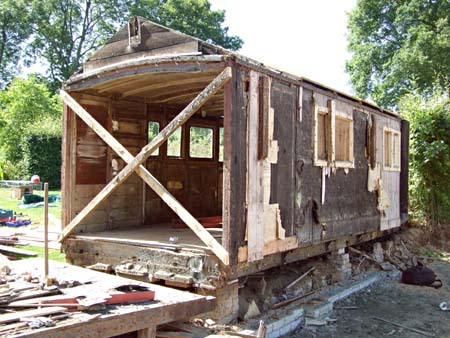
Above: Photos of the carriage, prepared for removal from Battle (Richard Salmon, 22 August 2009)
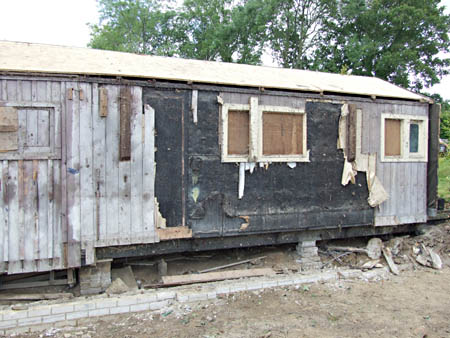 The exact details of this carriage are not yet fully researched, but it appears to be a Craven-era LB&SCR carriage dating from before 1860. It still retains its timber underframe, and the body is in a remarkable state of preservation, having been kept dry thanks to an overall roof and external timber cladding. It appears to have been a 4-wheeler, but the position of bolts protruding from the underframe (possibly to fix spring hangers) needs to be carefully examined (along with establishing which holes coincide with where horn-guides were fixed) to be certain that it was not an early 6-wheeler.
The exact details of this carriage are not yet fully researched, but it appears to be a Craven-era LB&SCR carriage dating from before 1860. It still retains its timber underframe, and the body is in a remarkable state of preservation, having been kept dry thanks to an overall roof and external timber cladding. It appears to have been a 4-wheeler, but the position of bolts protruding from the underframe (possibly to fix spring hangers) needs to be carefully examined (along with establishing which holes coincide with where horn-guides were fixed) to be certain that it was not an early 6-wheeler.
Right: the site, before work started to release the carriage from the adjoining annexe (Richard Salmon, 22 August 2009)
Initial research suggests that it is a second (later third) class vehicle with separate luggage and guard's compartments. The centre door on the "covered-over" side has what appears to be the LB&SCR Carriage garter emblem, with the number 221 at its centre, and "THIRD" lettering on the door waist panel. It's second-class origins are pointed to by the form of the seating (padded) and the varnish finish evident on the body beneath later layers of paint (thid-class vehicles of this period having been painted, second and first-class being varnished). Documentary evidence points to it having been numbered as 221 as a third-class vehicle in 1859, and it is therefore believed to have been downgraded from an earlier second-class vehicle (possibly dating from 1852). The underframe is 22ft long and the body 8ft wide, the bottom-side timbers unusually being fixed to cast cantilever brackets bolted to the underframe.
The photo below shows the underframe and one of the brackets, and also the horeshair insulation overlaying the body-side, which had then been covered over with tongued & grooved boarding.
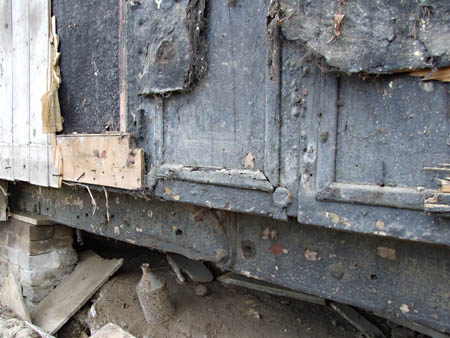 The carriage appears to have been moved onto its site in Battle in 1901, the same year as the adjacent quite substantial house was built. It was possibly intially used as site accommodation during the construction of the main property, although it may simply have been just an outbuilding.
The carriage appears to have been moved onto its site in Battle in 1901, the same year as the adjacent quite substantial house was built. It was possibly intially used as site accommodation during the construction of the main property, although it may simply have been just an outbuilding.
An annexe was added at one end around 1903-4, and timber cladding fixed to one side in 1905 (these dates being based on newspapers placed within the structure).
At some stage the opposite end, which would probably have been a brake compartment with raised lantern/birdcage roof was removed from the end (up to the position of a compartment wall), but the underframe remains intact for a further 4-ft (including the original headstock), forming a patio. In quite recent times, the patio end was rebuilt and the exposed side sympathetically restored (see photo at the top of the page), using the droplight from the end-most door on the covered side to replace a broken one on the other side.
An old photo of the carriage body in situ at Battle, with an additional extension beyond the brake end with a higher roof level, shows that the body originally almost certainly had a raised (lantern or birdcage) guard's lookout at the "missing" end.
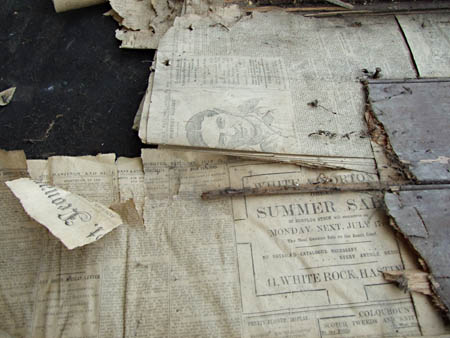
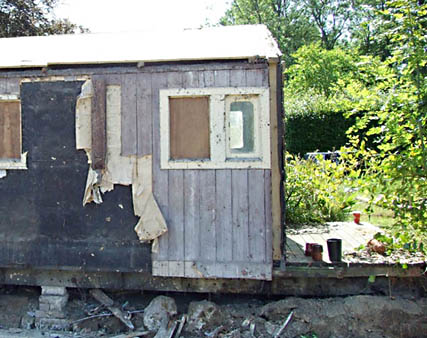
Left: 1905-dated newspapers (this is The Hastings and St. Leonards Observer for July 13th that year) lay beneath the exterior cladding
Right: The underframe and carriage floor (now a patio covered in modern decking) extends 4-ft beyond the remaining part of the body; the dished cut-out in the bottom-side member shows that there was a door at the extreme end of the vehicle (Richard Salmon, 22 August 2009)
The body has a very shallow arc roof, rising to about 6-ft headroom internally in the centre. The three passenger compartments (open above the seat backs) were lit by a single oil lamp (and the roof-plug still survives in situ). At the opposite end to the patio is a luggage compartment with a pair of doors on each side, mostly still retaining the original cladding, although one was apparently partly repanelled internally in railway days, and another with a more decorative tongue-and-groove planking in domestic times (with the same planking also extensively used on the inside of the domestic extension at that end). Unusually the passenger doors are hung with the hinges to the right (looking from the outside).
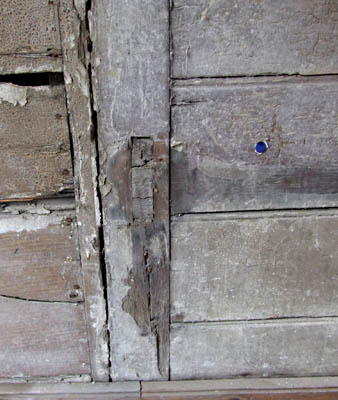 The form of the seats is clearly visible on the interior of the body (seen in the photo on the right). A substantial front-rail (morticed into the door pillar) had a moulded shape, with a substantial lip rising above the planked base, and a vertical planked back rose at least to the level of the large windows (side-lights) between the doors. This form of construction indicates that the seats were padded/upholstered, pointing probably to a second-class origin. The compartments are too small (and the interior details too plain) to have been first class. A roughly-carved recess above each door droplight possibly indicates that blinds were fitted later in its railway service. Covered with perforated metal internally, slatted ventilators run along the top of the passenger compartment sides, as well as in the tops of the doors. Whether these originally had an external cowl has not yet been determined.
The form of the seats is clearly visible on the interior of the body (seen in the photo on the right). A substantial front-rail (morticed into the door pillar) had a moulded shape, with a substantial lip rising above the planked base, and a vertical planked back rose at least to the level of the large windows (side-lights) between the doors. This form of construction indicates that the seats were padded/upholstered, pointing probably to a second-class origin. The compartments are too small (and the interior details too plain) to have been first class. A roughly-carved recess above each door droplight possibly indicates that blinds were fitted later in its railway service. Covered with perforated metal internally, slatted ventilators run along the top of the passenger compartment sides, as well as in the tops of the doors. Whether these originally had an external cowl has not yet been determined.
The carriage was used at some time as a workshop, and by the last owners as a children's play-room and garden room, and remarkably during the 108 years of domestic use there is no evidence of the interior being repainted. Externally there is evidence that both the underframe and body carried a varnished finish, this being revealed beneath a tar-wash applied presumably at the time of domestic delivery (certainly by 1905), although the end to which the extension was attached has evidence of maroon paint over a layer of cream (undercoat?), on top of the varnish.
We are most grateful to the owners of the property in Battle, Julian and Clare Hooton, for their very great desire to see it preserved for the future, for donating the carriage to the Bluebell, and for their very considerable assistance in preparing and facilitating its removal. They had initially offered it to their local railway (K&ESR), who were unable to take it, and we are also very grateful to the K&ESR for passing the details on to us.
After the demolition by builders of a garage which sat between the carriage and the road, a small team from the Bluebell helped prepare the carriage for extraction on Saturday 22nd August 2009, with the removal and delivery to the Bluebell taking place on the following Wednesday. On delivery to the Bluebell it has been placed as one of a number of vehicles on a bogie-carriage underframe, and immediately tarpaulined over. For such an early carriage to survive in such remarkable condition makes it of great historical importance, and the Bluebell Railway Trust (who have funded the transport costs and a tarpalin to protect it until such time as overhead cover becomes available) consider it to be a most worthy addition to the Bluebell's small but growing collection of 1850s' "Brighton" carriages.
POSTSCRIPT
Regrettably, the timbers of this carriage body were completely destroyed in an accidental fire at Horsted Keynes in the early hours of 16 July 2010. The fire appears to have been caused by sparks whipped up by extremely strong winds, from the embers of a bonfire which had been burning 20-30 feet away a day or two earlier. The metal components have been salvaged, and stored with the intention of reconstructing the vehicle, and putting it into an operational condition.
Origin: Probably LB&SCR
Type: Probably Brake second (later third), with luggage compartment at one end and a guard's compartment at the other
Built: 1850s?
No: probably 221 at time of withdrawal
Length: 22' over body, Width: 8'
Seats: probably 24 (second class) or 30 (third class) in 3 compartments.
Heating: unheated - footwarmers would have been available on request in the winter months.
Withdrawn: probably 1901
Sold by LB&SCR: probably 1901
Preserved: 2009
To Bluebell: 26 August 2009
Owner: Bluebell Railway Trust
Timbers destroyed: in an accidental fire, 16 July 2010


Return to BRPS Home Page,
to the Timetable or to Special
Events
Carriages & Wagons -
Intro -
Development -
Stock Lists: Carriages, Vans, Wagons & Multiple Units -
Carriage Fleet Review -
Join us
C&W Works News - SR Coach Group - Goods Division -
Operation Undercover -
Carriage Shop -
Technical Pages
Visitor Info. -
Museum -
Trust -
Catering -
Contacts -
What's New -
Projects -
Locos -
Carriages & Wagons -
Signals -
History -
Other -
Links -
Search -
FAQ
Why not become a BRPS Member? -
Get more involved as a Volunteer
Your ideal Film/TV location?
 Photos and text © copyright Richard Salmon31 August 2009. Drawings © copyright Ian White.
Photos and text © copyright Richard Salmon31 August 2009. Drawings © copyright Ian White.
Last updated by Richard Salmon, 25 October 2010 and 3 February 2021
© Copyright BRPS. Privacy Policy
|











